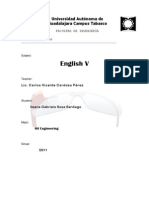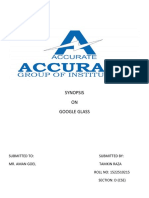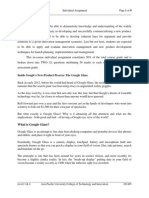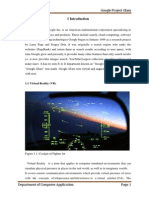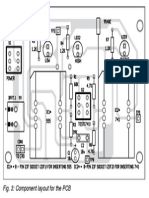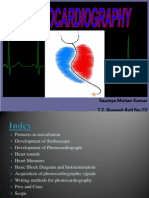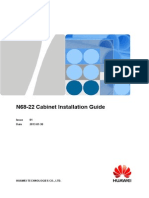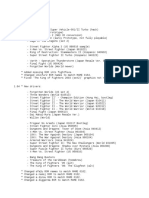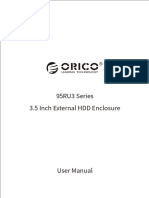Seminar Report: by Athul Santhosh CHM s5 Model Polytechnic College Mala, Kallettumkara
Seminar Report: by Athul Santhosh CHM s5 Model Polytechnic College Mala, Kallettumkara
Uploaded by
Rijy LoranceCopyright:
Available Formats
Seminar Report: by Athul Santhosh CHM s5 Model Polytechnic College Mala, Kallettumkara
Seminar Report: by Athul Santhosh CHM s5 Model Polytechnic College Mala, Kallettumkara
Uploaded by
Rijy LoranceOriginal Description:
Original Title
Copyright
Available Formats
Share this document
Did you find this document useful?
Is this content inappropriate?
Copyright:
Available Formats
Seminar Report: by Athul Santhosh CHM s5 Model Polytechnic College Mala, Kallettumkara
Seminar Report: by Athul Santhosh CHM s5 Model Polytechnic College Mala, Kallettumkara
Uploaded by
Rijy LoranceCopyright:
Available Formats
2013
SEMINAR REPORT
By Athul Santhosh CHM s5 Model polytechnic college Mala, Kallettumkara
Page |2
Google GLSS
Page |3
Chapter no.
GOOGLE GLASS
Page no
OVERVIEW OF GOOGLE GLASS
2 3 DESIGN
TECHNICAL SPCIFICATIONS
DISPLAY OF GOOGLE GLASS SPEAKER OF GOOGLE GLASS PROCESSOR TOUCH PAD CAMERA&MICROPHONE
OVERALL WORKING
SOME FIELDS THAT MAY CHANGE WITH GOOGLE GLASS
CONCLUSION
Page |4
About GLASS:
Project Glass is a research and development program by Google to develop an augmented reality head-mounted display (HMD). It is part of the Google X Lab, which works on other futuristic technologies. The intended purpose of Project Glass products would be the hands-free displaying of information currently available to most smart phone users, and allowing for interaction with the Internet via natural language voice commands. The functionality and physical appearance (minimalist design of the aluminium strip with 2 nose pads) makes this device Glass is an attempt to free data from desktop computers and portable devices like phones and tablets, and place it right in front of your eyes. Essentially, Google Glass is a camera, display, touchpad, battery and microphone built into spectacle frames so that you can perch a display in your field of vision, film, take pictures, search and translate on the go.
Page |5
GOOGLE GLASS : OVERVIEW
entertainment and, this being a Google product, may be advertisements too onto the lenses. These glasses have the combined features of virtual reality and augmented reality. The Google Glasses can use a 4G cell connection to pull in information from Googles mountain of data and display info about the real world in augmented reality on the lens in front of your eye. As you turn your head youll get information about your surroundings and nearby objects from Google Goggles, info on buildings and establishments from Google Maps, even your friends nearby check-ins from Latitude. The company has no plans to sell ads into your newly augmented view of the world, but will consider it if the product really catches on.
Figure : Overview of Google Glass The glasses are not being designed to be worn constantly although Google engineers expect some users will wear them a lot but will be more like smart phones, used when needed, with the lenses serving as a kind of see-through computer monitor. Google glasses are basically wearable computers that works with the help of Android phones and tablets (or simply a bluetooth enabled phone) . Unlike smart phones and tablets, the glasses are not equipped with GPS, they pair up with any android device for the purpose. They contain a camera and audio inputs and output systems .Several people who have seen the glasses, said that the location information was a major feature of the glasses. Through the built-in camera on the glasses, Google will be able to stream images to its rack computers and return augmented reality information to the person wearing them. For instance, a person looking at a landmark could see detailed historical information and comments about it. If facial recognition software becomes accurate enough, the glasses could remind a wearer of when and how he met the vaguely familiar person standing in front of him at a party. They might also be used for virtual reality games that use the real world as the playground.
Page |6
SPECIFICATIONS OF GOOGLE GLASS explorer edition
Also known as project Glass
Developer: Google Manufacturer : Foxconn USA
Type : Augmented reality (AR),head-mounted display (HMD),Wearable technology, Wearable computer Release date : Developers (US): February 2013 Developer version: $1,500 USD Android(4.0.4)
Introductory price : Operating system : Power
: Rechargeable battery
CPU: OMAP 4430 SoC, dual-core Storage capacity: 16 GB Flash total (12 GB of usable memory) Memory: 1GB RAM (682MB available to developers) Display : Prism projector (equivalent of a 25 in. screen from 8 ft. away) Sound : Bone conduction transducer
Input : Voice command through microphone Controller input : Touchpad, MyGlass phone app Camera : Photos - 5 MP, videos - 720p Connectivity : Wi-Fi 802.11b/g, Bluetooth, micro USB Backward Compatibility : Any Bluetooth-capable phone; MyGlassApp requires Android 4.0.3 (Ice Cream Sandwich) or higher Website : google.com/glass
Page |7
DESIGN
Display of Glasss
Page |8
Google Glass uses display technology that puts data in front of your vision courtesy of a prism screen This is designed to be easily seen without obstructing your view(visual overlaying). According to Google, the display is equivalent of a 25 inch high definition screen eight feet away. Overlaying data to users field of vision has obvious benefits, Directions become more intuitive (although there is no GPS on board so you will have to pair it with your phone) User can view realtime translations or transcriptions, and you can scroll through and reply to messages
Speaker of Glass
Speaker of glass is a bone conduction headphone
Figure : comparison between traditional headphones and bone conduction transducer Traditional headphones vibrates the air inside the air and the air induces vibrations on the ear drum and one is able to hear the sound but the technology used in google glass is different , google glass uses bone conduction technology to produce sound. Bone conduction headphone vibrates the cranial bones to make the user hear sound. This technology wasnt introduced by google , bone
Page |9
conduction headphones already exist . google adapted this because it has the following benefits Induces vibrations on the cranial bones directly unlike traditional headphones Does not block external noise Maintains sound clarity in very noisy environment
Processor
Processor used in google glass is OMAP SoC 4430 dual core . OMAP (Open Multimedia Applications Platform) is a series of image/video processors developed by Texas Instruments. . OMAP 4430 is the 4th generation OMAP. It runs at clock speed of 1.2GHz. OMAP has Integrated 3D graphics accelerator. It also uses a dual-channel LPDDR2 memory controller compared to Nvidia Tegra 2's single-channel memory controller.
Controller Touch pad
Touch pad is also an important part of glass , length is from users temple to ear. Just a tap is required to wake up the glass (google glass will wake up to its home screen , a clock ) . then the timeline will be displayed. Scroll to the cards of the time line and tap to select one. Swipe down anywhere to go back.
Camera ,microphone
Google glass consists of a camera which can take photos of 5 MP and record videos upto 720p. Microphone is inbuilt , for voice commands and text input.Voice command or button can be used to take pictures& videos
P a g e | 10
WORKING
Google glass requires a phone to work Android device with o.s version 4.0.3 or above (or any blue tooth enabled phone) for using navigation glass needs android phone . It pairs up with phone to establish a connection to internet. User can communicate with the device via voice commands (Natural language) Eg. Ok glass, now take a picture for taking photo
P a g e | 11
FIELDS THAT MAY CHANGE
Online distance education Whether it's cooking, auto mechanics or beauty tips, Google Glass will make distance learning more fun, interactive and accessible.
Aviation Imagine pilots using Google Glass to receive turn-by-turn directions to their destination or nearest airport. With Glass as the ultimate heads-up display, coordinates and descriptions of nearby landmarks would be visible at all times, No need to look down at the control panel.
Healthcare Experts believe augmented reality will have many uses in the medical field, especially during complicated surgery.
Law Enforcement/Armed Forces Google Glass could make law enforcement professionals could document suspicious or criminal activity in progress and potentially use the video footage as evidence
P a g e | 12
CONCLUSION
Exciting device with data and network integration
Costly for individuals Great business, learning, data and services Boon for many professionals like Doctors & police officers Assistance to disabled individuals The best navigation experience
You might also like
- Samsung TV AV BrochureDocument9 pagesSamsung TV AV BrochureRijy LoranceNo ratings yet
- The ZAIN Free Internet Browsing ManualDocument19 pagesThe ZAIN Free Internet Browsing ManualMichael Ayobami AdelekeNo ratings yet
- Processor OrganizationDocument6 pagesProcessor Organizationgo2_sumit100% (1)
- Google Glasses PDFDocument17 pagesGoogle Glasses PDFVipul KrNo ratings yet
- English V: Universidad Autónoma de Guadalajara Campus TabascoDocument5 pagesEnglish V: Universidad Autónoma de Guadalajara Campus Tabascoigabriela_sNo ratings yet
- Google Glass Paper Presentation - PROJECT GLASS ODPDocument32 pagesGoogle Glass Paper Presentation - PROJECT GLASS ODPGowtham RajNo ratings yet
- Google Glass: Overview and User GuideDocument18 pagesGoogle Glass: Overview and User Guidemarinagomez1No ratings yet
- Mobile Version GGLDocument27 pagesMobile Version GGLKaranPatilNo ratings yet
- Google GlassDocument18 pagesGoogle GlassPradeep KumarNo ratings yet
- Google GlassDocument22 pagesGoogle GlassAjay Narahari0% (1)
- Google Glasses: SKBR - Pg.College AmalapuramDocument6 pagesGoogle Glasses: SKBR - Pg.College AmalapuramAnonymous Zg6BlT3No ratings yet
- IMNPD Assignment UC4F1401Document9 pagesIMNPD Assignment UC4F1401suglavinaayaganNo ratings yet
- Google Glass: A Project ReportDocument14 pagesGoogle Glass: A Project ReportankitaNo ratings yet
- Googleglass HARI VALLABH - 1Document28 pagesGoogleglass HARI VALLABH - 1Saloni SharmaNo ratings yet
- Google Glass Seminar ReportDocument30 pagesGoogle Glass Seminar ReportVishalSahNo ratings yet
- Synopsis ON Google GlassDocument3 pagesSynopsis ON Google GlassNiyaz AhmadNo ratings yet
- Google Glass (Final)Document21 pagesGoogle Glass (Final)Mohammed Arsalan RezaNo ratings yet
- Google GlassDocument22 pagesGoogle GlassAbhinav ArakkanNo ratings yet
- Imnpd AssignmentDocument9 pagesImnpd AssignmentMin HouNo ratings yet
- Google Glass PresentationDocument25 pagesGoogle Glass PresentationVenu Kinng100% (1)
- Google Glass Seminar ReportDocument26 pagesGoogle Glass Seminar ReportNiladri Paul100% (1)
- About Google: Google Inc. Is An American Multinational Corporation Specializing inDocument3 pagesAbout Google: Google Inc. Is An American Multinational Corporation Specializing inNAGENDRANo ratings yet
- Google GlassDocument17 pagesGoogle GlassNagarajuNeeliNo ratings yet
- Google Glass PPT 1Document22 pagesGoogle Glass PPT 1Ankit KumarNo ratings yet
- Google Glass: © MAR 2018 - IRE Journals - Volume 1 Issue 9 - ISSN: 2456-8880Document4 pagesGoogle Glass: © MAR 2018 - IRE Journals - Volume 1 Issue 9 - ISSN: 2456-8880Yash RajanNo ratings yet
- Gooogle Glass Abstract1Document2 pagesGooogle Glass Abstract1saisrilekhaNo ratings yet
- Glλss: Google Glass ("GLΛSS") es un dispositivo de visualización tipo gafas de realidadDocument5 pagesGlλss: Google Glass ("GLΛSS") es un dispositivo de visualización tipo gafas de realidadEfrainmt Pucheta RosseessNo ratings yet
- Google Glass: Submitted byDocument6 pagesGoogle Glass: Submitted byJoe SathyanarayananNo ratings yet
- Department of Electronics and Communication: Miss Rashmi Gome AVINASH KHARCHE (0802EC111022) EC A, Semester VDocument28 pagesDepartment of Electronics and Communication: Miss Rashmi Gome AVINASH KHARCHE (0802EC111022) EC A, Semester VFarhan LaeeqNo ratings yet
- Feature SpecificationDocument6 pagesFeature SpecificationVandita KhudiaNo ratings yet
- G Oogle Glass: Project GlassDocument5 pagesG Oogle Glass: Project GlassShant ChouguleNo ratings yet
- Google-Glass-Seminar-Report MODIFIED by LOHITHDocument27 pagesGoogle-Glass-Seminar-Report MODIFIED by LOHITHlohith jvsNo ratings yet
- V2i3 0118 PDFDocument4 pagesV2i3 0118 PDFAmrutanarkhedeNo ratings yet
- Google Glass FinalDocument27 pagesGoogle Glass Finaldavidsasi1lyNo ratings yet
- Google Glass-Seminar ReportDocument23 pagesGoogle Glass-Seminar ReportAnanthuSibyNo ratings yet
- Assignment IMNPD UC4F1411Document9 pagesAssignment IMNPD UC4F1411EugeneChoongNo ratings yet
- Godhani Sarkar: Presented ByDocument27 pagesGodhani Sarkar: Presented ByMaurya RahulNo ratings yet
- Google Glasses: by Sai Charan Reddy Mutyala 12N61A0536Document23 pagesGoogle Glasses: by Sai Charan Reddy Mutyala 12N61A0536Charan Reddy MutyalaNo ratings yet
- Krishna Google Glass ReportDocument14 pagesKrishna Google Glass ReportKrishna SinghNo ratings yet
- Research Paper On Google Glass in Ieee FormatDocument4 pagesResearch Paper On Google Glass in Ieee Formatafeascdcz100% (1)
- DFP 30033 Case Sudy 2 (Autorecovered)Document8 pagesDFP 30033 Case Sudy 2 (Autorecovered)Desmond rajNo ratings yet
- Google GlassesDocument23 pagesGoogle GlassesArshad ShaikNo ratings yet
- Google Project Glasses: A Seminar Report OnDocument30 pagesGoogle Project Glasses: A Seminar Report OnNilesh Kumar ParjapatiNo ratings yet
- Applications of Google Glass-ReviewDocument7 pagesApplications of Google Glass-ReviewGRD JournalsNo ratings yet
- Google GlassDocument20 pagesGoogle GlassMujahid UsmanNo ratings yet
- Presentation 1Document12 pagesPresentation 1Siddhu Sasaank NallamothuNo ratings yet
- New Advances For Output DevicesDocument5 pagesNew Advances For Output DevicesLisaNo ratings yet
- Thumbi SeminarDocument29 pagesThumbi Seminarmathewmanu516No ratings yet
- Google Glass Seminar ReportDocument41 pagesGoogle Glass Seminar ReportmlwececehodNo ratings yet
- Android VersionsDocument7 pagesAndroid VersionsEdna Mae Salas GarciaNo ratings yet
- Abstract:: Project Glass Is A Research and Development Program by Google To Develop An AugmentedDocument8 pagesAbstract:: Project Glass Is A Research and Development Program by Google To Develop An AugmentedHari Krishna RoyNo ratings yet
- Google GlassDocument30 pagesGoogle GlassShreejith NairNo ratings yet
- Abstract: Augmented Reality (AR) : Project Glass Is A Research andDocument6 pagesAbstract: Augmented Reality (AR) : Project Glass Is A Research andvineetpaladi100% (2)
- A Review On Google Glass and Its Technologies: C.Durga K.Swathi A.Ramadevi M.NarmadaDocument8 pagesA Review On Google Glass and Its Technologies: C.Durga K.Swathi A.Ramadevi M.NarmadaEditor InsideJournalsNo ratings yet
- Android NotesDocument142 pagesAndroid NotesrafiNo ratings yet
- Google Glass: A Seminar Report OnDocument12 pagesGoogle Glass: A Seminar Report OnjoeNo ratings yet
- Google Glass EditedDocument26 pagesGoogle Glass EditedAnirudh MaheshwaramNo ratings yet
- Business Proposal of Google GlassDocument15 pagesBusiness Proposal of Google GlassVandita KhudiaNo ratings yet
- Google Glasses: G.Akshitha Reddy 15N81A0502Document12 pagesGoogle Glasses: G.Akshitha Reddy 15N81A0502gurram akshitha reddyNo ratings yet
- Your First Pixel Phone: The Ridiculously Simple Guide to the Pixel 4 and 4XL (and Other Devices Running Android 10)From EverandYour First Pixel Phone: The Ridiculously Simple Guide to the Pixel 4 and 4XL (and Other Devices Running Android 10)No ratings yet
- The Ridiculously Simple Guide to Pixel Go, Pixelbook, and Pixel Slate: Getting Started With Chrome OSFrom EverandThe Ridiculously Simple Guide to Pixel Go, Pixelbook, and Pixel Slate: Getting Started With Chrome OSNo ratings yet
- Mastering the Pixel 9 and Pixel 9 Pro: The Ultimate Guide for Beginners and BeyondFrom EverandMastering the Pixel 9 and Pixel 9 Pro: The Ultimate Guide for Beginners and BeyondNo ratings yet
- The Ridiculously Simple Guide to Google Pixel: A Beginners Guide to Pixel 3, Pixel Slate and PixelbookFrom EverandThe Ridiculously Simple Guide to Google Pixel: A Beginners Guide to Pixel 3, Pixel Slate and PixelbookNo ratings yet
- Bio-Artificial Liver: Shahana Shihab, Thahany. S and Saju Simon.S.GDocument8 pagesBio-Artificial Liver: Shahana Shihab, Thahany. S and Saju Simon.S.GRijy LoranceNo ratings yet
- A Seminar ON Microsoft Hololens: Submitted By: Arjun E K CHM S5 Roll No.12Document21 pagesA Seminar ON Microsoft Hololens: Submitted By: Arjun E K CHM S5 Roll No.12Rijy LoranceNo ratings yet
- 4D Technology: Smart Phones, Smarter TeachingDocument8 pages4D Technology: Smart Phones, Smarter TeachingRijy LoranceNo ratings yet
- Tester For 555 Timer Fig 3Document1 pageTester For 555 Timer Fig 3Rijy LoranceNo ratings yet
- MullaDocument40 pagesMullaRijy LoranceNo ratings yet
- CarbonDocument4 pagesCarbonRijy LoranceNo ratings yet
- Final Cut ProDocument16 pagesFinal Cut ProRijy LoranceNo ratings yet
- TUISurvey FN THCI2010Document140 pagesTUISurvey FN THCI2010Peter H WongNo ratings yet
- Justin Horrell SDocument20 pagesJustin Horrell SRijy LoranceNo ratings yet
- Areas of Application of OOP ConceptDocument2 pagesAreas of Application of OOP ConceptRijy LoranceNo ratings yet
- Nidhin Paul Chms6 Roll No.32Document16 pagesNidhin Paul Chms6 Roll No.32Rijy LoranceNo ratings yet
- Free CV Template 197Document1 pageFree CV Template 197Rijy LoranceNo ratings yet
- Deepthi Webclustering ReportDocument38 pagesDeepthi Webclustering ReportRijy Lorance100% (1)
- Cluster ComputingDocument43 pagesCluster ComputingDebmalya GhoshNo ratings yet
- Echo Cancellation Techonology: Presented by Vishnuprasad.M.VDocument19 pagesEcho Cancellation Techonology: Presented by Vishnuprasad.M.VRijy LoranceNo ratings yet
- Indroduction: Design of A New Firewall Based On NetfilterDocument17 pagesIndroduction: Design of A New Firewall Based On NetfilterRijy LoranceNo ratings yet
- AbstractDocument1 pageAbstractRijy LoranceNo ratings yet
- Map ADocument2 pagesMap APacu BerjemaahNo ratings yet
- Pspice For Thevenin and Norton Equivalents Pspice ReviewDocument6 pagesPspice For Thevenin and Norton Equivalents Pspice ReviewHanis HabidinNo ratings yet
- DS1337 I C Serial Real-Time Clock: General Description FeaturesDocument16 pagesDS1337 I C Serial Real-Time Clock: General Description FeaturesCarlos ArangurenNo ratings yet
- SpectrumDocument6 pagesSpectrumBenetton ČačakNo ratings yet
- Meriva EPS ChrastiDocument5 pagesMeriva EPS ChrastiJubril AkinwandeNo ratings yet
- Opcode Vision and Opcode Studio Vision 4.5 MIDI Reference Manual 1999Document499 pagesOpcode Vision and Opcode Studio Vision 4.5 MIDI Reference Manual 1999nifnifnafnafNo ratings yet
- Introduction To Approximation Algorithms: Proximation Ratio. Informally, For A Minimization Problem Such As The VDocument15 pagesIntroduction To Approximation Algorithms: Proximation Ratio. Informally, For A Minimization Problem Such As The VPritish PradhanNo ratings yet
- Simad University Operating Systems (I) Chapter 1: Introduction To OS Quiz One: Open Book Solution Multiple Choice QuestionsDocument16 pagesSimad University Operating Systems (I) Chapter 1: Introduction To OS Quiz One: Open Book Solution Multiple Choice QuestionsCasho MohamedNo ratings yet
- Log.2017 08 03 11 04 48 0500Document28 pagesLog.2017 08 03 11 04 48 0500PisitoNo ratings yet
- Law of Exponential GrowthDocument4 pagesLaw of Exponential GrowthnishagoyalNo ratings yet
- Customer Substation Manual - WE EnergiesDocument85 pagesCustomer Substation Manual - WE Energiesjeb13No ratings yet
- Mobile Back SkinDocument9 pagesMobile Back SkinSushil KumarNo ratings yet
- N68E-22 Cabinet Installation Guide (01) (PDF) - enDocument84 pagesN68E-22 Cabinet Installation Guide (01) (PDF) - enAnonymous iAYcAhNo ratings yet
- X515ea Ej1744wDocument3 pagesX515ea Ej1744wAugusto Ramirez CisnerosNo ratings yet
- DVD Movie Factory User ManualDocument19 pagesDVD Movie Factory User ManualcotedaniNo ratings yet
- ControlSpace Remote v2.0 ReleaseNotesDocument5 pagesControlSpace Remote v2.0 ReleaseNotesohundperNo ratings yet
- WhatsnewDocument26 pagesWhatsnewAttique RehmanNo ratings yet
- Program Creation For DOSDocument5 pagesProgram Creation For DOSJoseGarciaRuizNo ratings yet
- XSIM Telemetry Data To MotorsDocument10 pagesXSIM Telemetry Data To MotorsperrociegoNo ratings yet
- Contoh Assignment.. Guna Untuk Guideline..Document3 pagesContoh Assignment.. Guna Untuk Guideline..Adb RoslanNo ratings yet
- XTU 4.2 BIOS Interface SpecificationDocument48 pagesXTU 4.2 BIOS Interface Specificationdavidvivienda2No ratings yet
- Oxygen Sensor InstructionsDocument4 pagesOxygen Sensor Instructionsbargain bangbangNo ratings yet
- Dse7560 Data Sheet PDFDocument2 pagesDse7560 Data Sheet PDFGeorge AniborNo ratings yet
- Final Stndar HRG 2018Document921 pagesFinal Stndar HRG 2018pkm kedungwunguNo ratings yet
- Kernel ServicesDocument10 pagesKernel ServicesVibhor SharmaNo ratings yet
- ORICO 95RU3 Series - Manual (9528RU3 - 9548RU3 - 9558RU3)Document20 pagesORICO 95RU3 Series - Manual (9528RU3 - 9548RU3 - 9558RU3)huy tranNo ratings yet
- Labview: Lego Mindstorms NXT Module Programming GuideDocument97 pagesLabview: Lego Mindstorms NXT Module Programming GuideJhonYoplacNo ratings yet
- Lab 2Document15 pagesLab 2Fyon ChinNo ratings yet




